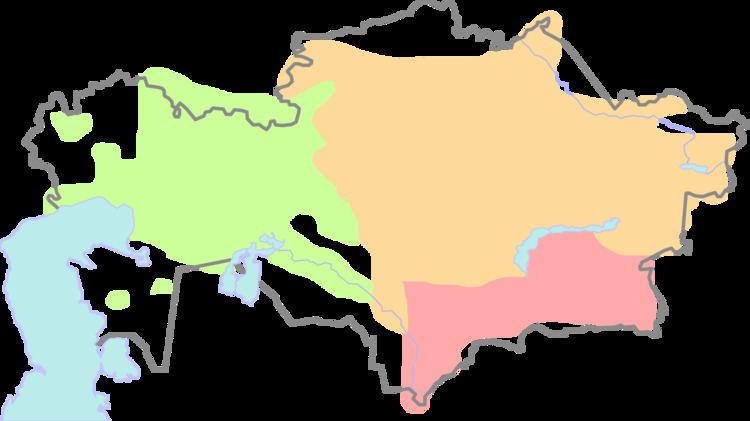 | ||
A zhuz (Kazakh: жүз jüz ء جۇز [ʒʉz], also translated as "horde" or "hundred") is one of the three main territorial and tribal divisions in the Kypchak Plain area that covers much of the contemporary Kazakhstan, and represents the main tribal division within the ethnic group of the Kazakhs.
Contents
History
The earliest mention of the Kazakh jüz or hordes dates to the 17th century. Velyaminov-Zernov (1919) believed that the division arose as a result of the capture of the important cities of Tashkent, Yasi, and Sayram in 1598.
Some researchers argued that the jüz in origin corresponded to tribal, military alliances of steppe nomads that emerged around mid-16th century after the disintegration of the Kazakh Khanate. Yuri Zuev argued their territorial division comprises three ecological or topographic zones, the Senior zhuz of the southern and southeastern steppe being set apart from the two other zones by Lake Balkhash.
According to Kazakh legends, the three jüz were the territorial inheritances of the three sons of the mythical founder father of the Kazakhs. In Kazakh language, jüz means either "union" or "hundred".
Senior zhuz
Historically, the Senior zhuz (Kazakh: Ұлы жүз, Ulı jüz, ۇلى ء جۇز; Russian: Старший жуз, Staršij žuz) inhabited the northern lands of the former Chagatai Ulus of the Mongol Empire, in the Ili River and Chu River basins, in today's South-Eastern Kazakhstan and China's Ili Kazakh Autonomous Prefecture (northern Xinjiang). It was also called Üysin jüz.
The first record of the Senior zhuz dates to 1748, due to a Tatar emissary of the Tsaritsa who had been sent to the steppe to negotiate the submission of Abul Khair Khan in 1732. According to Nikolai Aristov, the estimated population of the Senior zhuz was about 550,000 people in the second half of the 19th century. The territory was conquered by the Kokand Khanate in 1820s, and by the Russian Empire during the 1850s to 1860s.
Kazakhstan's ruling elite, including current president Nursultan Nazarbayev, former First Secretary of the Communist Party of Kazakhstan Dinmukhamed Konayev, as well as famous poet Jambyl Jabayev are representatives of the Senioren zhuz.
There have been several attempts to determine the exact names and nature of top level clans throughout the 19th and early 20th centuries. However, different studies created vastly different names and population numbers for the steppe clans. Generally accepted names of the first order Senioren zhuz tribes or clans are:
Middle zhuz
The Middle zhuz (Kazakh: Орта жүз, Orta jüz, ورتا ء جۇز; Russian: Средний жуз, Srednij žuz), also known as Arğın jüz, occupies the eastern lands of the former Golden Horde, in central, northern and eastern Kazakhstan.
Some of Kazakhstan's famous poets and intellectuals were born in the Middle zhuz territories, including Abay Qunanbayuli, Akhmet Baytursinuli, Shokan Walikhanuli and Alikhan Bokeikhanov.
The Middle zhuz consists of the following tribes:
Junior zhuz
The Junior or Lesser zhuz (Kazakh: Кiшi жүз Kişi jüz, كىشى ء جۇز; Russian: Младший жуз Mladšij žuz), also known as Alşın jüz, occupied the lands of the former Nogai Khanate in Western Kazakhstan. It was also called Alşın jüz.
They originate from the Nogais of the Nogai Horde, which once was placed in Western Kazakhstan, but in the 16th century it was defeated by the Kazakhs and the Russians and Nogais retreated to the Western part of their khanate, to the Kuban River steppes. In the 18th century they endanged inner Russian cities, so the Russian Empire allied the Kalmucks (Kalmyks) to supplant Alshyns back to the Urals. There they formed the Lesser zhuz. During Kazakh-Kalymk struggles, Khiva Khanate annexed Mangyshlak Peninsula for repelling Kalmyk raids and managed it for two centuries before Russian conquest. In the beginning of the 19th century, Kazakhs shifted some to the west, to Astrakhan Governorate, forming Bukey Horde there. As the Kazakh SSR was formed with Bukey Horde as the most remoted its western part, situated geographically in Europe.
Historical leaders of Kazakh resistance against the Russian Empire associated with the Junior zhuz include Isatay Taymanuly (Kazakh: Исатай Тайманұлы, 1791—1838) and Makhambet Otemisuly (Kazakh: Махамбет Өтемісұлы, 1803/4–1846).
The Junior zhuz consisted of three groups, subdivided into clans:
